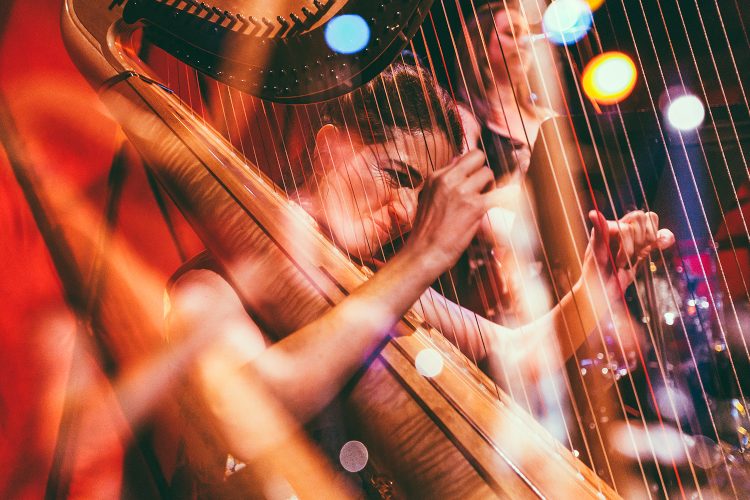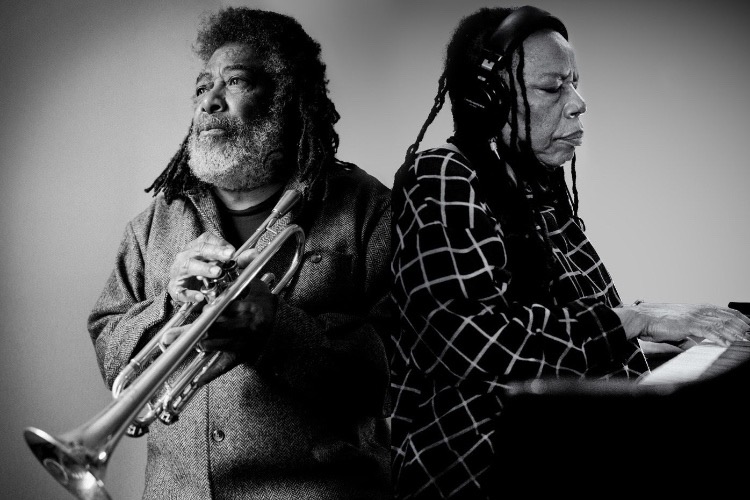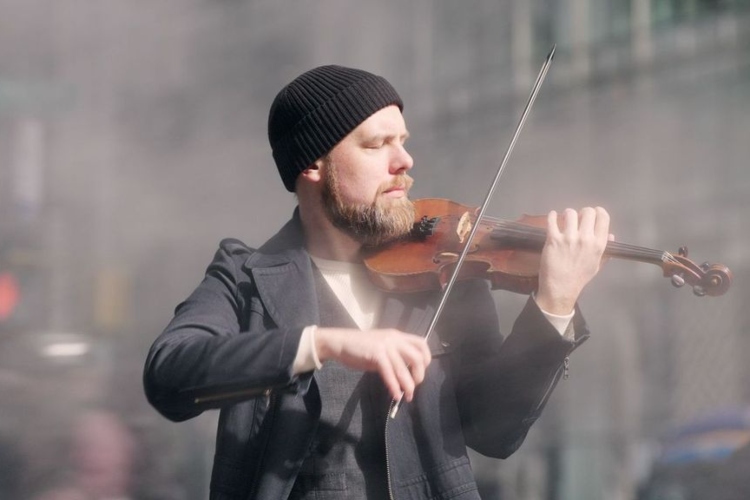Days in December: A Conversation with Jacqueline Kerrod
|
Getting your Trinity Audio player ready...
|
Historians believe some form of the harp existed as far back as the beginning of ancient Egypt’s “Old Kingdom”, 2500 BC. Even as early as 4,500 years ago, it was commonplace for a harpist to give solo performances. Across the ages, the instrument adapted and changed to meet the musical needs of the time. Despite this, the magic of a lone artist plucking its strings has remained. Jacqueline Kerrod continues this tradition with 17 Days in December (Orenda, 2021) by not merely revisiting that which came before her.
To a large degree, Kerrod’s solo debut obliterates any preconceptions one may have about the harp. While she masterfully uses the instrument’s graceful timbre to craft her message, it seems such is just one of many colors in her kit. As she even notes in our conversation, “at my core, I think I’m a guitarist/bassist/maybe a pianist.” Though she sometimes uses small hand tools or electronic effects to produce these new sounds, impressively, often she eschews modifications and plays it unaltered. The end product is raw and intimate, a secret entryway into the emotions and thoughts of a unique musical mind.
17 Days in December’s rawness may come partly from the circumstances in which Kerrod produced recorded the album. Not originally intended for release, the tracks took life as an experiment in which Kerrod recorded herself in her home studio every day during December 2020 as much of the outside world shutdown around her. It may also come through time spent with other artists and ensembles who have themselves pushed the boundaries of music, including Anthony Braxton, Alarm Will Sound, the Talea Ensemble, and the International Contemporary Ensemble. We sat down with Kerrod to discuss her influences, her history with the harp, and the album.
PostGenre: You started playing the harp at age 9. At what point did you decide to explore outside of solely the instrument’s stereotypical comfort zone of classical music, including the use of improvisation and extended techniques?
Jacqueline Kerrod: Growing up in South Africa I listened to a lot of Joni Mitchell, Pink Floyd, Rodriguez, a ton of rock and heavy metal via my older brothers, and was drawn to electronic music. It was in my early 20s that I became interested in making my own music, but I’d only dip my toe in occasionally and then let it go. My interest in improvisation came a bit later because I longed to be able to play my instrument, not only play pieces on my instrument. After moving to NYC I started playing a lot of contemporary music in large ensembles, small chamber groups, and solo, all of which exposed me to the range of extended techniques.
I don’t think my motivation has ever been consciously about pushing the boundaries of the harp. I just want to play and make music that pushes me and the harp happens to be the instrument I have dedicated my life to. And the relationship is a complicated one. Very much a love/hate thing going on that I’m always trying to navigate. At the core, I love the physicality of the instrument. I spend a good deal of my life hugging this large resonant body and, since I’m quite small, it takes a lot of strength and energy. I want to express everything and I personally love creating space for a lot of beautiful jangle!
PG: When did you start playing an electric harp and what do you like most about using pedals and a looper?
JK: I bought my first electric harp in 2007, the same time I bought my acoustic pedal harp, but it sat in the closet for about 4 years! I pulled it out when I started writing in my former vocal and harp duo, Addi & Jacq.
What drew me to using an electric harp and a looper was the idea of making the harp sound bigger. I could be the band, which was convenient for many reasons. I have always wanted to envelop a listener in the sound … glorious … huge… harp sound! Whenever I think of it, I think of the sound of Bjork or Radiohead. That kind of full depth and layering of sound. But while looping was useful in the pop duo context I began to feel stuck musically, which is partly why I opted not to use it on the album. It pushed me to find alternate ways of creating a sense of layers.
PG: Even though your background is in classical performance, do you draw any inspiration from someone like Alice Coltrane or Dorothy Ashby who explored improvisation on the harp in the past?
JK: I have a background that is wider than only classical performance, which this album finally puts together. While I have a deep respect for Ashby and Coltrane, I don’t feel their music has had such an influence on me. Yes, they both played the harp, but I am not always drawn to listening to the harp. I have to say though, Zeena Parkins’ work on Bjork’s Vespertine (One Little Indian, 2001) will always stay with me! That album gave me hope with regards to my instrument! The harp felt necessary, edgy, powerful!
PG: What was it like working with Kanye West and how do you feel that experience has shaped your own music?
JK: My work with Kanye West was not in a creative role. I showed up to shows several hours early with 6-10 other female instrumentalists, had extensive makeup done, and put on the clothes we were given, including a gigantic visor. It’s not easy to play the harp sporting headgear! It’s just one of those things that’s a really cool and bizarre experience that ends up on one’s bio because it’s true!
PG: 17 Days in December came about when you decided to capture yourself each day during quarantine in December of 2020. Initially, you did not originally intend to release the album in any formal way. At what point did you decide it would be great to have those experiments become a recording?
JK: Initially, I was going to take the improvisations as source material for more formal compositions. Then I listened again and realized that what I loved about the improvisations is the realness in the vulnerability of imperfections, all the spots that are ‘mistakes’. I also liked the way I played the material and felt I’d lose that sense of subtle timing if I tried to recreate it. In the end, I decided that this was a moment in time. I felt happy with the work I did and wanted to move on to other projects. Thanks to some great harpists releasing albums during the pandemic I saw the harp in the news a lot, and I feel that my album contributes to the conversation.
PG: Do you feel- in light of the circumstances of how it was recorded- the album conveys some of your emotions regarding quarantines and shutdowns?
JK: I think the emotional content has less to do with the negativity of the shutdown and Corona and more to do with the opportunity presented by not being constantly busy and on the road. I felt a lot of energy (physical and creative) to make my own music in a way that felt free, creative, and joyful.
PG: Noticeably, the days are not in chronological order across the album’s tracks. What was your thought process behind the ordering of the tracks?
JK: The first half of December was on acoustic, then I switched to electric for the rest of the month simply because I didn’t have adequate space in my room for both set-ups. Listening back, I didn’t enjoy the separation of the instruments so I decided to mix them up in a way that would feel surprising to the listener.
PG: At certain points in the album, you use objects – a screwdriver-like tool, a glass bowl, and a viola bow – to make music. Where did you get the idea to incorporate these objects into the music-making process?
JK: I love the screwdriver because I can get microtones and slides. The glass bowl made the electric sound like a mbira and also has the effect of sliding. I used the bow to create a sense of layering and sustain while not using a looper. I have a bit of sustain envy because notes are fixed and decay on the harp. These were my solutions to this conundrum!
PG: Other than the use of objects a few times and moments on electric harp, most of the album is you on unaltered harp showcasing extended techniques. Was that a conscious choice to show the range the instrument has on its own?
JK: I am drawn to music that jangles, that has overdrive, that has that rawness. I think of the music of Ali Farka Touré, Toumani Diabaté, Kaki King, Fiona Apple. I’m drawn to the jangle of strings combined with the technical facility, discipline, and courage to be authentic. I decided not to prepare the harp so I could change direction on a whim without having to add/remove something physical from the instrument.
PG: You have performed with Anthony Braxton in various projects, including Trillium J, ZIM Music, and your duet album together. What do you feel you have learned the most from working with him?
JK: Oh, there is so much! I owe Mr. Braxton a huge debt of gratitude for giving me real-time experiences in the world of creative improvised music. The generosity and openness to welcome me into his world was the biggest gift anyone could have given me. His Language Music showed me a simple yet powerful strategic way of getting inside the creative space.
All the experiences gave me the tools and courage to be myself, but also opened up a whole new world of music, community, and ways of listening. Of course, I already knew and admired the most famous jazz musicians: Fitzgerald, Armstrong, Davis, Coltrane, etc., but through Braxton, I began my exploration.
Although I had a lot to learn (and still do), having played so much classical contemporary music, there was a lot I could relate to in Braxton’s music. This was my entry point, and it was so inspiring to see, through his work, how musical worlds could collide and make beautiful sense. I was able to give myself the permission to mix all my own influences and experiences and bring them out in ways that felt and feel true to me.
PG: One of Braxton’s best-known works is a solo saxophone recording, For Alto (Delmark, 1971). Part of what makes that album excel is his willingness to push his instrument beyond its typical comfort zone. Do you see a parallel between For Alto and 17 Days in December?
JK: That anyone would draw a parallel is flattering, but it honestly never occurred to me. Solo harp, like solo piano, seems like the most natural thing in the world. If my music brings more awareness to the instrument, that is a wonderful byproduct of what I set out to do, which was to discover my own music.
I think what you’re picking up on is that I’m looking for other ways to express myself, and I think it honestly stems from this complicated relationship I have with my instrument. At the core, I think I’m a guitarist/bassist/maybe a pianist. Those are a lot of the sounds that ring in my ears and heart.
17 Days in December will be available on Orenda Records on December 3, 2021. It can be pre-ordered on the label’s website or on Bandcamp.
More information on Jacqueline can be found on her website.




2 thoughts on “Days in December: A Conversation with Jacqueline Kerrod”